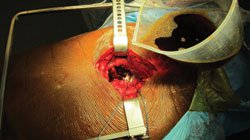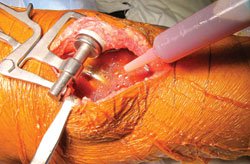Dilute betadine lavage protocol reduced infection rates after total joint replacement
Investigators noted that the protocol has also shown efficacy in a published spine study by Cheng and colleagues.
The use of dilute betadine lavage prior to surgical closure reduced acute postoperative infection rates in total joint arthroplasty from 0.97% to 0.15%, according to a study comparing more than 2,000 cases.
Nicholas Michael Brown, MD, shared his team’s findings at the 2011 Annual Meeting of the American Academy of Orthopaedic Surgeons, in San Diego.
“Deep periprosthetic joint infection is rare, but obviously a devastating complication when it does occur; associated with extensive physical, economic and psychological costs,” Brown said.
Although efforts are made to reduce infection — such as careful aseptic technique, skin preparation, prophylactic antibiotics, and laminary air flow in the operating room — following total joint arthroplasty, it still remains a problem, he reported.
“Even with measures in place, we still see reported infection rates in the literature of 0.3% to about 1.9%,” Brown said. “It has been shown in spine patients that dilute betadine lavage prior to closure can reduce this infection rate.”
Change in protocol
In June 2008, Brown reported the senior surgeon, Orthopedics Today Editorial Board member Craig J. Della Valle, MD, switched to a protocol of using dilute (0.35%) betadine lavage for 3 minutes prior to wound closure in total hip and total knee arthroplasty cases. The solution is made by adding 17.5 ml of 10% povidone-iodine in 500 cc of normal saline, resulting in a 0.35% dilution. The povidone-iodine is obtained from the prep kits that are available sterile on the operative field.
“[The betadine] was followed by cleansing with 1L of normal saline pulse lavage … and then finally painting the skin with the 10% povidone-iodine solution from the swab sticks prior to the final closure,” Brown said. “This was in addition to the standard protocol, which all patients in the series received that included prophylactic antibiotics prior to the incision and for 24 hours postoperatively.”
|
|
|
|
Application of dilute betadine is shown at the end of a total hip arthroplasty (left) and a total knee arthroplasty (right). Images: Della Valle CJ |
|
The researchers analyzed 1,862 consecutive cases, which included 630 hips and 1,232 knees, before the protocol was initiated and compared the results with 688 consecutive cases of 274 hips and 414 knees that were performed after the infection protocol was adopted. In all cases, investigators searched for any instance of acute postoperative infection, which was defined in the study as a deep periprosthetic joint infection occurring within 90 days after the procedure.
Brown reported there were no significant demographic differences between the groups with regards to age, gender or primary diagnosis.
Reduced infection rates
Periprosthetic joint infection was defined in the study as either two positive cultures taken from within the joint or cases that had two of the following criteria: at least one positive culture taken from within the joint, gross purulence seen during surgery, or histopathology consistent with infection. Using this definition, Brown reported, the group saw a strong reduction in the rate of infection.
“What we saw was a 0.97% infection rate prior to the use of betadine and a 0.15% infection rate after the onset of betadine usage,” he said. “This was statistically significant.”
According to the study abstract, there were 18 acute postoperative infections (0.97%) before the protocol. Following its implementation, there was one case of such infection (0.15%).
“In conclusion, we saw that betadine is safe,” Brown concluded. “It has minimal toxicity to human tissue when it is dilute, it is inexpensive — about a dollar per packet — it is easy to use and, at least in our study, we found it to be effective as we saw a statistically significant decrease in acute postoperative infections. Given the retrospective nature of the study, however, we do interpret these results with caution and have initiated a prospective study to try to confirm these results.” – by Robert Press
References:
- Brown NM, Cipriano CA, Moric M, Della Valle CJ. Dilute betadine lavage prior to closure for preventing acute deep periprosthetic joint infection. Paper #128. Presented at the 2011 Annual Meeting of the American Academy of Orthopaedic Surgeons. Feb. 15-19. San Diego.
- Cheng MT, Chang MC, Wang ST, et al. Efficacy of dilute betadine solution irrigation in the prevention of postoperative infection of spinal surgery. Spine. 2005;30(15):1689-1693.

- Nicholas Michael Brown, MD, can be reached at 1611 West Harrison Street, Suite 300, Chicago, IL 60612; email: nmb2116@gmail.com.
- Disclosure: Brown has no relevant financial disclosure.



